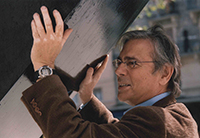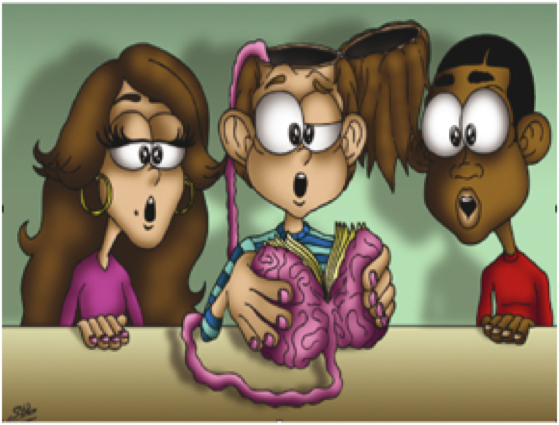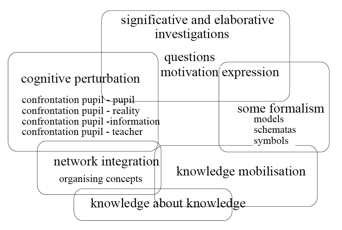
|
| |
News / Just released
Currently these publications are in French or translated into different languages, unfortunately not in English ...
Following the best-seller of Learning to learn, Librio is currently reissuing:
A. Giordan, J. Saltet, Apprendre à apprendre (Learning to Learn), Librio
A. Giordan, J. Saltet, Learning to Revise (Apprendre à réviser), Librio
A. Giordan J. Saltet, Learning to Succeed (Apprendre à réussir), Librio
A. Giordan, J. Saltet, Learning to Take Notes (Apprendre à prendre des notes), Librio
Golay A. and A. Giordan, Practical guide for therapeutic patient education, Maloine
A. Giordan, Thirty years without medication (30 ans sans medicaments), Lattès
A. Giordan and A. Golay, Living well with his disease (Bien vivre avec sa maladie), Lattes, 2013
is now available in Paperback.
Completed reissue of two collectors at the origin of Science Didactics
The origins of knowledge, Delachaux, Neuchatel, 1987, reissue at Ovadia 2020
under the title Origins of knowledge.
Science education, how to make it work? Z’Editions 1989
reissue by Ovadia, 2020 under the title Scientific éducation
The MOOC Learning LDES product with the University of Geneva and André Giordan
is available free of charge.
https://www.unige.ch/fapse/ldes/apprendre/inscription/
|

What’s new about learning ?
André Giordan
During the past 25 years, biology has developed to the extent of replacing physics as a reference subject. Social awareness has grown, as has the need to assess the impact of biology on our society. Topics related to health, to the environment, or to social issues - and in particular, to ethical ones - have become priorities. As a result, there is a growing demand for biology education and media reports. Yet most scientists focus their énergies on a frantic race towards research results. Few are really interested in sharing their knowledge. First we have to convince them: this is becoming an urgent necessity.
In this context, we should discuss what could be an initiation to biology. With issues such as biotechnology and food production, DNA and genetic manipulations, artificial fertilization and cloning, listeria or mad cow disease, what knowledge do people need to master for individual and social evolution? They certainly don’t need to develop abilities in all fields of research. This would be physically impossible, since the amount of existing knowledge currently doubles every 8 years.
Moreover, it is difficult to predict which basic knowledge will be required in the coming twenty or fifty years. Most of it is probably still to be discovered. To a certain extent the purpose is not to communicate biology. What is essential is to provide each individual with the opportunity to acquire a certain culture through the study of
biology. What becomes fundamental is to stimulate each person to become open minded and able to acquire new knowledge.
The second important issue we worked on is learning: when we observe biology education in schools and in the media, three great traditions emerge.
Classical learning models
The first considers learning a simple recording mechanism. “Virgin” brains, which are always accessible, acquire knowledge as the direct result of transmission. In schools, this refers to the so-called “logical” presentation of data which is now frequently illustrated. In museums, this usually means exhibiting objects or documents with explanatory tags. Such empirical pedagogy assumes a linear, frontal Relationship between a broadcaster (teacher, journalist, museum specialist), the holder of knowledge, and a receiver (pupil or general public), who memorizes consecutive messages.
The second tradition relies on training, which is elevated to the rank of principle. Situations are conceived, and accompanied by questioning to which immediate answers are provided. Learning is favored by “rewards” (positive reinforcement) or “punishments” (négative reinforcement). Through such conditioning, the individual eventually adopts the right behavior, the one which avoids the negative reinforcement. Education offers self-programmed exercises; exhibits provide push-button situations. Computerized teaching has often returned to that principle.
The third tradition is the so-called pedagogy “of construction.” It takes root in the spontaneous needs and “natural interests” of individuals. It advocates their free expression, their creativity and their knowledge of how to be. propounds independent discovery, or the importance of feeling one's way in the learning act. The individual is no longer content with receiving crude data; he or she selects and assimilates them. The construction of knowledge is operated largely by action and the expression of the pupils' representations. A certain number of research centers are built on the educational model and based on these so-called “active methods”, such as the Children's Museum in Boston, or the Cité des Enfants de la Villette near Paris.
In fact, this last tradition has many facets. Two American psychologists, Gagné and Bruner, emphasize the “associations” which are to be established between external information and the structure of thought. Ausubel and, similarly, Novak, were more explicit and talked of “cognitive points” at the end of the sixties. Gerald Schaefer proposes the idea of associate chains in his heuristic “zigzag” model. The Piaget school in Geneva puts forward the concepts of “assimilation” and “accommodation,” borrowed from developmental and evolutionary biology. All organisms assimilate what they take from the exterior into their own structures, including the information retrieved by their perceptions. That process is accompanied in turn by an accommodation, i.e., a modification of the organs on a biological plane or of the intellectual instruments on the cognitive plane. If the subject wants to assimilate knowledge, he or she must be capable of permanently accommodating his or her way of thinking to the demands of the situation.
Limits of the constructivist models
It appears that each individual must learn on his own and nobody can do it for him (or her). The meaning attributed to knowledge cannot be directly transmitted. Only the learners themselves can elaborate their own meanings, compatible with what they are, and through their own experience.
Active and inquiry methods are no simple solution to this problem, however, as they have several limitations (see below).
Everything does not simply depend on general cognitive structures.
> The more a situation differs from mastered knowledge, the more we use primitive reasoning strategies.
Knowledge is not always automatically appropriated via “reflective abstraction” (Piaget)
> Deconstruction of the learner's concepts should be a previous stage.
> Construction and deconstruction are interactive processes. New knowledge is only really installed when previous knowledge is deleted.
Constructivists isolate the individual learner.
> They minimize the role of the environment.
> They ignore the fact that development takes place within society. Cultural environments help provide meaning to situations.
The different facets of constructivism are largely silent on the contexts and conditions which favor learning:
- idea of “maturation,” natural development, or “equilibration.”
- “co-action,” “cognitive conflict” or “conceptual changes.”
> Such projects still poorly indicate the required situations or resources when facing the complexity of integrated education. |
Main limits of the constructivist models
The learner has a specific mode of explanation - called conceptions - which déterminâtes the way it decodes information and constructs knowledge. It's the only instrument (panel), he has at disposal (Giordan 1978, Giordan et De Vecchi, 1987). Learning depends on these prior thinking notions. It is also through them that the learner interprets information spread by the teacher or the media. If teaching does not consider this fact, if teaching does not work on the learners conceptions, the sitting notions hold their own and the conveyed knowledge is evaded, transformed or stay isolated from the familiar knowledge. Now this hypothesis is largely corroborate. It appears that the learning of any piece of knowledge depends on the pupils conceptions, and if the teacher ignores them, "sitting" notions work as an obstacle (a sort of snag). This hypothesis has conducted our laboratory to produced a lot of researches in this field. Mainly we have categorised different conception on different subjects, we have explained the different obstacles.
We have also constructed different tools to define what is a conception and how it's work. In a first approximation, we can say that the conception is not only an image, an simple idea, a simple production of the reality. It is a thinking process, a answer to a question. The conception present different levels of organisation.
But today we must go further. The knowledge of the pupils conceptions is useful, but not sufficient. The new research question is : how to use learner conception ? Learning includes a number of many, multifunctional and pluricontextulized activities. Learning mobilises several levels of mental organisation that, at first glance, seem disparate as well as a considerable number of regulation loops (feed-back). Trying to explain everything with one single theory is attempting the impossible. In order to go beyond the constructiviste model, a number of micromodels have been created and gathered under the comprehensive term : allosteric learning model. They describe what is going on in the learner’s head as well as the general conditions that make learning easier.
Allosteric learning model
A student learn simultaneously "thanks to" as says (Gagné 1965), "starting from" (Ausubel 1968), "with" (Piaget 1950, 1977), the functional knowledge inside his mind, but at the same time, he must learn" against" it (Bachelard 1934, 1938). Learning is a highly active mental process which works in a conflicting way and in an intégrative mode between what the learner has in his mind and what he can find and understand through his conceptions on his environment.
When a learner elaborates a new model, all his mental model must be reelaborated in aninteraction between the conception and the external information. And this, is not obvious. Student changes ideas with a lot of difficulties.
Mainly his questioning network must be completely reformulated, his framework of references, largely reorganised. And when a pupil changes his conception, it's not because he is convinced that it doesn't work, it's because he has elaborated another one which is more efficient to answer to the question he is confronted with. And this need conflict and interference periods and the elaboration of knowledge goes on with approximation, concernation, confrontation, decontextualisation, interconnexion, rupture, alternate, emergence and mobilisation periods.
On their own, learners clearly have a slim chance of discovering which set of éléments can modify their questions, concepts or relationship to knowledge. Teachers can facilitate the production of meaning by filtering multiple items of information, by amplifying or by reducing the input of external stimuli.
Teaching biology and making it accessible to a wider public requires an increasingly complex alchemy. It is now possible to systematically classify the essential parameters which facilitate the learning process.
| |
 |
Main allosteric learning parameters
First, the teaching environment (classroom, museum, media) must provide learners with meaningful situations. We must trigger the desire to learn. To do so, the context must stimulate, motivate, concern or challenge learners, leading them to a questioning approach. Multiple confrontations are required: a single argument is not enough. We can either encourage pupil-reality confrontations, via surveys, observations, and experiments, or pupil-pupil confrontations, when learners work in groups and different ideas oppose each other. This can be completed by confrontations with (written or audiovisual) information. All these activities must be sufficiently pertinent to challenge current learner conceptions. They must convince learners that their conceptions are not adequate for dealing with the problem(s) at hand. Thus, the activities must lead learners to investigate, help them formulate their thoughts, and distance themselves from ideas which were previously taken for granted. Finally, they can help learners collect new data and broaden their experience.
It is important for learners to have access to an adequate level of formalism, as it encourages the elaboration of more adequate conceptions. This may take many guises (symbols, models, conceptual maps,...), and either provide food for thought, or assistance when thinking things through. In the latter case, formalism should encourage learners to rephrase problems, and/or consider additional links. In order to be operational, such formalism must be easy to access and manipulate. Finally, it must help organize diverse data, and can serve as an anchor when shedding light on reality.
Further, we need to provide situations in which learners can mobilize their new knowledge, and test its efficiency and limitations. Such situations must show that new data are more easily accessed or learned when using the new thought structures. Thus, learners learn to activate knowledge; in certain cases, they may also imagine
individualized types of guidance .
Since biology education is such a long and complex process, knowledge must be integrated into a network of ‘organizing concepts’. We will not develop this idea any further in this section, because it is a topic in itself.
Finally, learners must be able to implement ‘knowledge about knowledge’. The main obstacle in this case is often the representation learners have of biology or of their own approach. Learners have trouble grasping the scope or importance of certain knowledge, or of the ‘logic’ underlying a given approach, without alternating learning moments with moments of ‘metacognition’ (see appendix on germination).
Changes in the professions of teaching and promoting biology
To date people who taught biology in school and in the media simply distributed knowledge. They thought their work was over after having said or shown. Yet current
ideas on the real meaning of ‘learning’ demonstrate how complex and demanding the professions of teacher or creator of exhibits have now become. Their primary role is to ‘organize’ learning conditions.
Therefore, such professionals must transform their own conceptions of ‘teaching’. They must abandon the idea of a panacea. When teaching science or promoting a culture of biology, vaccines and ready-made pills do not exist. At best, we can provide multitherapies...
We must involve a whole cocktail of parameters when staging each Learning situation and create an allosteric environment which is liable to transform learner conceptions. This should involve several elements (see figure), which interact with one another. The teacher must dose them in order to perturb without destabilizing. If successful, they must know how to accompany learners without completely taking them in charge.
In the end, all of this revolves around paradoxes which must be regulated. For example, teaching must be based on learners, while going against what learners think. Likewise, we must encourage self-teaching in museums, for example, yet simultaneously confront learners with challenging and meaningful situations.
Bibliography
Ausubel D.P. et al., 1968, Educational psychology, a cognitive view, Holt, Rinehart and Winston.
Bachelard G., 1934, Le nouvel esprit scientifique, PUF, Paris.
Bachelard G., 1938, La formation de l'esprit scientifique, Vrin, Paris.
Gagné R.M., 1965, The condition of learning, Holt, Rhinehart and Wiston.
Giordan, A., 1978, Une pédagogie pour les sciences expérimentales, Centurion, Paris.
Giordan, A., De Vecchi, G, 1987, Les origines du savoir, Delachaux, Neuchâtel.
Piaget J., 1950, Introduction à l’épistémologie génétique, PUF, Paris.
Piaget J. et al., 1977, Recherches sur l’abstraction réfléchissante, Puf, Paris.
To know more on the allosteric learning model
Giordan, A., From constructivism to allosteric learning model, In A call for action,
Takezono Tsukuba: Tsukuba Shuppankai, 1994. - P. 185-195.
Giordan, A., Girault, Y. and Clement, P., eds. 1994, Conceptions et connaissance, Peter Lang, Neuchâtel.
Giordan, A., New models to learn ? In Prospect, Vol. 25(1995), no 1, p. 109-127.
Giordan, A., Girault, Y., eds,. 1996, New learning models, Z'Editions, Nice.
Giordan, A. 1998, Apprendre !, Belin, Paris.
|